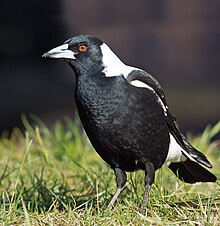| Australian magpie | |
|---|---|

| |
| G. tibicen hypoleuca, Tasmania | |
| Scientific classification | |
| Domain: | Eukaryota |
| Kingdom: | Animalia |
| Phylum: | Chordata |
| Class: | Aves |
| Order: | Passeriformes |
| Family: | Artamidae |
| Subfamily: | Cracticinae |
| Genus: | Gymnorhina Gray, GR, 1840 |
| Species: | G. tibicen
|
| Binomial name | |
| Gymnorhina tibicen (Latham, 1801)
| |
| Subspecies | |
|
9, see text | |

| |
| Natural range | |
| Synonyms | |
|
Cracticus tibicen | |

Taveuni, Fiji
The Australian magpie (Gymnorhina tibicen) is a black and white passerine bird native to Australia and southern New Guinea, and introduced to New Zealand, and the Fijian island of Taveuni.[2] Although once considered to be three separate species, it is now considered to be one, with nine recognised subspecies. A member of the Artamidae, the Australian magpie is placed in its own genus Gymnorhina and is most closely related to the black butcherbird (Melloria quoyi). It is not closely related to the Eurasian magpie, which is a corvid.
The adult Australian magpie is a fairly robust bird ranging from 37 to 43 cm (14.5 to 17 in) in length, with black and white plumage, gold brown eyes and a solid wedge-shaped bluish-white and black bill. The male and female are similar in appearance, but can be distinguished by differences in back markings. The male has pure white feathers on the back of the head where the female has white blending to grey feathers. With its long legs, the Australian magpie walks rather than waddles or hops and spends much time on the ground.
Described as one of Australia's most accomplished songbirds, the Australian magpie has an array of complex vocalisations. It is omnivorous, with the bulk of its varied diet made up of invertebrates. It is generally sedentary and territorial throughout its range. Common and widespread, it has adapted well to human habitation and is a familiar bird of parks, gardens and farmland in Australia and New Guinea. This species is commonly fed by households around Australia, but in spring (and occasionally in autumn) a small minority of breeding magpies (almost always males) become aggressive, swooping and attacking those who approach their nests. Research has shown that magpies can recognise at least 100 different people, and may be less likely to swoop individuals they have befriended.[3]
Over 1,000 Australian magpies were introduced into New Zealand from 1864 to 1874,[4] but were subsequently deemed to be displacing native birds and are now treated as a pest species.[5] Introductions also occurred in the Solomon Islands and Fiji, where the birds are not considered an invasive species. The Australian magpie is the mascot of several Australian and New Zealand sporting teams, including the Collingwood Magpies, the Western Suburbs Magpies, Port Adelaide Magpies and, in New Zealand, the Hawke's Bay Magpies.
- ^ BirdLife International (2018). "Gymnorhina tibicen". IUCN Red List of Threatened Species. 2018: e.T22706288A131945700. doi:10.2305/IUCN.UK.2018-2.RLTS.T22706288A131945700.en. Retrieved 11 November 2021.
- ^ Kaplan, Gisela; Rogers, Lesley J. (23 July 2013). "Stability of referential signalling across time and locations: testing alarm calls of Australian magpies (Gymnorhina tibicen) in urban and rural Australia and in Fiji". PeerJ. 1: e112. doi:10.7717/peerj.112. ISSN 2167-8359. PMC 3728765. PMID 23904991.
- ^ "Vic masks could fire up swooping magpies". Australian Associated Press. 19 August 2020. Archived from the original on 6 November 2020. Retrieved 22 September 2020.
- ^ Heather, Barrie; Robertson, Hugh (2015). The Field Guide to the Birds of New Zealand. Auckland, New Zealand: Penguin Books New Zealand. p. 413. ISBN 978-0-143-57092-9. OCLC 946520191.
- ^ "Magpie". Greater Wellington Regional Council. Archived from the original on 11 August 2023. Retrieved 11 August 2023.
